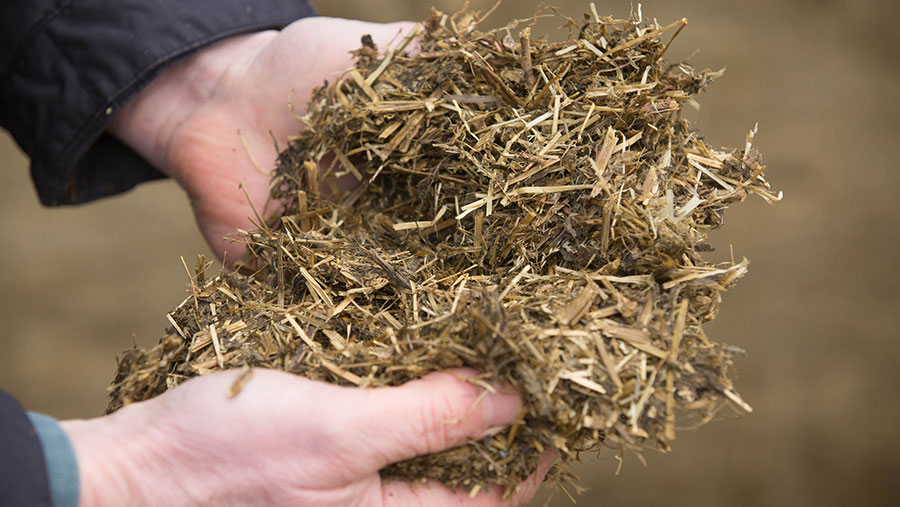How to get the most from this year’s variable silage crop
 © Tim Scrivener
© Tim Scrivener This year’s silage is proving to be variable in quality and will need careful and frequent monitoring to make the best use of it.
That is the verdict on samples from more than 2,100 first cuts and 1,170 second cuts tested by Trouw Nutrition GB’s analytical laboratory.
Results confirm the effect of an extended and inconsistent harvest season – with a mild winter and the hottest April on record, followed by cold nights that stopped grass growth – for first cuts, and knock-on effects for second cuts, according to Trouw’s ruminant technical development manager, Liz Homer.
Challenges
“The variable quality within and between clamps is going to present some practical challenges, but farmers who analyse clamps regularly will be best placed to make the most of forages this winter,” she says.
There are some good-quality first cuts, but later cuts are more variable. Overall, silages are low in protein and digestibility, and high in fibre.
This means it is important to ensure diets are supplying enough metabolisable protein in the form of rumen fermentable protein and bypass protein to avoid a drop in milk production.
Five key tips for feeding this year’s silage crop
- Get your silage analysed frequently by a reputable lab, and consult your feed adviser to ensure you’re making best use of it
- Silages low in protein will need supplementing with a rumen-fermentable supplement such as rape, soya or distillers’ grains
- Consider the effect neutral detergent fibre (NDF) levels and digestibility have on intake. For example, if heifers are being fed on poorer-quality silage, will they meet growth rate targets?
- Rumen efficiency is key to profitability – make sure high-NDF silages are balanced with rumen-fermentable protein and keep a close check on acid load and fibre index to maintain good rumen health
- Look out for changes in the levels of milk constituents and in the consistency of the cows’ dung, and check they are ruminating
“If you are feeding a perfectly balanced diet with first-cut silage, and then move to second cut, you will see a 1- to 1.5-litre drop in milk yield because the digestibility will be lower,” says Dr Homer.
Rumen health needs monitoring to ensure the fibre in the diet is supporting buffering and not passing straight through the digestive system. And while energy levels in this year’s silage are generally good, the rumen needs to be balanced.
Regular sampling
This year’s average first cut is 33% dry matter (DM), 11.3MJ metabolisable energy/kg DM, 12.9% crude protein and 44.5% neutral detergent fibre. However, there is a considerable range between crops, so it is vital that farmers analyse their own clamps regularly.
Dr Homer says: “Cows like consistency, so farmers need to get individual forages analysed, and analysed more regularly. For a 250-cow herd we would recommend sampling clamps every three weeks.
“Taking a representative sample can be done in the time it takes the mixer wagon to mix a diet, so time should not be an issue. As results are typically back in 24 hours, you will be well placed to decide on what changes to make, if any.”
Average 2021 first- and second-cut grass silage and early wholecrop analysis |
|||
|
|
First-cut average |
Second-cut average |
Wholecrop average |
|
Number of samples |
2,125 |
1,173 |
447 |
|
Dry matter (DM) (%) |
33.6 |
35.3 |
40.9 |
|
Crude protein (% DM) |
12.9 |
13.5 |
8.5 |
|
D-value (%) |
70.9 |
68.1 |
66.7 |
|
ME (MJ/kg DM) |
11.3 |
10.9 |
10.4 |
|
NDF (% DM) |
44.5 |
45.7 |
41.4 |
|
Starch (% DM) |
|
|
28.1 |
|
Acid load |
49.5 |
47.5 |
47.4 |
|
Fibre index |
178.6 |
183.7 |
174.4 |
|
Dynamic energy (MJ/kg DM) |
5.99 |
5.95 |
5.57 |
|
NDIP (g/kg DM) |
59.3 |
60.0 |
41.7 |
|
Rapidly fermentable carbohydrates (g/kg DM) |
210.4 |
197.4 |
211.3 |
|
Total fermentable carbohydrates (g/kg DM) |
450.3 |
444.5 |
424.0 |
|
Rapidly fermentable protein (g/kg DM) |
81.3 |
83.0 |
49.4 |
|
Total fermentable protein (g/kg DM) |
93.9 |
96.6 |
55.5 |
|
NutriOpt fermentable energy and protein balance (g/kg DM) |
-1.53 |
2.35 |
-26.4 |
|
Source: Trouw Nutrition GB |
|||
